
The Coast, Kenya
This guide details information to plan your visit and fully enjoy the city's unique charm.
Mombasa is a distinct coastal city located on Mombasa Island. It sits on the southeastern coast of Kenya, directly bordering the warm waters of the Indian Ocean. Bridges connect the island to the mainland. The Nyali Bridge links Mombasa to the north, for access to popular beach resorts. To the west, the Makupa Causeway offers a land route to the mainland.
A ferry service, the Likoni Ferry, provides access to the south coast, which includes Diani Beach. Kilindini Harbour, Mombasa's port, is a position of great importance. It ranks as the largest port in East Africa, serving not only Kenya but also landlocked countries in the region. This geographical placement on the Indian Ocean has shaped Mombasa's identity for centuries, making it a natural gateway for trade and cultural exchange.
Mombasa's history stretches back to the 12th century, establishing its role as a major trading hub on the East African coast. It played a pivotal part in the extensive Indian Ocean trade network. This network linked African kingdoms with merchants from the Middle East, India, and China. The city saw various periods of foreign rule, each leaving a distinct mark.
Evidence of these historical layers appears throughout Mombasa. The architecture of Old Town, for example, combines Swahili, Arab, and Indian elements, featuring intricately carved doors and balconies. The city's cuisine, language, and traditions reflect this long, layered history of interaction and exchange. Every street and building tells a story of explorers, traders, and empires, making Mombasa a living museum of East African coastal history.
Emerges as a major trading hub on the East African coast.
Portuguese presence to control trade routes.
Construction of Fort Jesus, an UNESCO World Heritage site.
Omani Arabs establish dominance, influencing culture and language.
Mombasa used as a strategic port and administrative center.
Its identity forms from a rich blend of Swahili, Arab, Indian, and British influences. This cultural fusion shines through in its distinctive architecture, aromatic cuisine, and long-held traditions. The city draws visitors with its white-sand beaches, ancient historical sites, and thriving marine national parks. These natural and historical attractions provide a wide range of activities for travelers.
Mombasa attracts visitors with its pristine beaches, historical sites like Fort Jesus, and marine life. Activities include water sports, city exploration, and cultural immersion.
Beyond its appeal to tourists, Mombasa functions as a significant commercial and industrial center. Kilindini Harbour, the largest port in East Africa, forms a backbone of Kenya's economy, facilitating trade across the region.
The combination of its historical depth, cultural vibrancy, and economic importance makes Mombasa a destination with many layers. It is a place where visitors can relax on the beach, explore ancient ruins, savor unique flavors, and experience a lively urban environment all in one location. The city presents a comprehensive view of Kenya's coastal identity.
Mombasa offers a dynamic mix of experiences for every type of traveler. From historical exploration to relaxing beach days, the city delivers diverse attractions.
Discover aspects that make Mombasa an unique destination.
Explore marine national parks and nearby wildlife reserves for a close look at Kenya's diverse ecosystems.
Wander through Old Town's ancient alleys and visit historic sites like Fort Jesus to discover Mombasa's rich past.
Relax on white-sand beaches, engage in water sports, and enjoy the tropical coastal environment.
Mombasa is a major commercial and industrial hub, notably with Kilindini Harbour.